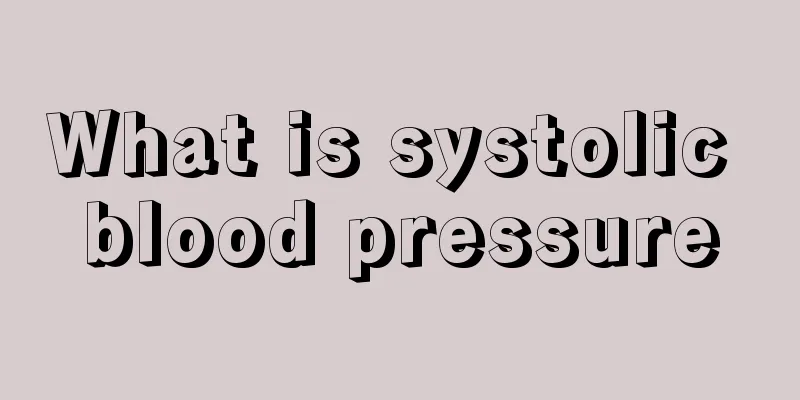What is systolic blood pressure

|
The so-called systolic blood pressure refers to the pressure in the arteries rising when the human heart contracts, and mid-systolic blood pressure appears. The greater the pressure in the arteries, the greater the blood pressure, so it is called high blood pressure. Normal people and children have normal systolic blood pressure. If it exceeds the normal systolic blood pressure, it means that you are diagnosed with high blood pressure. What is systolic blood pressure and what are the general measurement standards? Systolic pressure is the pressure in the arteries that rises when the human heart contracts. In the middle of the heart contraction, the pressure in the arteries is the highest. At this time, the pressure of the blood on the inner wall of the blood vessel is called systolic pressure, also known as high pressure. According to the World Health Organization, adults can be diagnosed with hypertension when their systolic blood pressure is ≥140 mmHg or (and) their diastolic blood pressure is ≥90 mmHg. Basic Information General Standards According to the World Health Organization, adults can be diagnosed with hypertension when their systolic blood pressure is ≥160 mmHg (21.3 kPa). Systolic blood pressure ≤130mmHg (18.6kPa) is called normal blood pressure, and that between the two is called borderline hypertension; so-called hypotension refers to the systolic blood pressure of arterial blood pressure lower than 12 kPa (90 mmHg). There are differences in different age groups and genders. Fold to edit this section Clinical significance Systolic blood pressure is of great clinical significance. There is a type of hypertension called systolic hypertension, which means that the diastolic blood pressure is normal but the systolic blood pressure is increased. Among various types of hypertension, increased systolic blood pressure is the most common and more difficult to control. Clinical observations have found that a simple increase in systolic blood pressure with aging makes stroke and acute coronary events more likely to occur. Therefore, doctors will pay more attention to the patient's systolic blood pressure in clinical practice. In recent years, a large number of epidemiological, evidence-based medicine and clinical studies have confirmed that the harm caused by systolic hypertension may be greater than increased diastolic blood pressure. The so-called isolated systolic hypertension refers to hypertensive patients whose systolic blood pressure is ≥140 mmHg but whose diastolic blood pressure is not high (lower than 90 mmHg). Even if the diastolic blood pressure is not high, if the systolic blood pressure is 160-179 mmHg, it can be regarded as moderate hypertension; systolic blood pressure ≥180 mmHg is severe hypertension, and should be treated accordingly according to this classification combined with coexisting risk factors. For those without risk factors, systolic blood pressure should be controlled below 140 mmHg; for patients with isolated systolic hypertension with diabetes or kidney disease, systolic blood pressure should be controlled below 130 mmHg. Systolic blood pressure becomes more important as you age. In adults over 50 years old, systolic blood pressure exceeding 140 mmHg is a more important risk factor for cardiovascular disease than elevated diastolic blood pressure. The standard of systolic blood pressure is very important to us. Generally, when measuring blood pressure, we will observe the systolic blood pressure to determine whether our body has high blood pressure. With age, systolic blood pressure becomes more important, especially for adults over 50 years old, who need to measure their blood pressure regularly every week. |
<<: What are the correct ways to wash vegetables?
>>: What are the methods to remove static electricity from clothes?
Recommend
How to prevent headaches after a nap
Many people experience headaches after a nap. If ...
What are the symptoms of liver cancer in the middle and late stages? 3 symptoms of liver cancer in the middle and late stages that you should know
Cancer may not have obvious symptoms in the early...
What is pulmonary fibrosis? Causes of pulmonary fibrosis
The main symptom of pulmonary fibrosis is dyspnea...
How to care for liver cancer patients with fever? 3 home care for liver cancer patients with fever
1. Fever caused by bacterial infection Practice: ...
What are the complications of colorectal cancer?
Colorectal cancer refers to a malignant tumor of ...
My face feels burning when I touch skincare products
As the skin care market continues to grow, it is ...
Six tips for coping with late spring cold weather and keeping healthy Who should pay more attention to late spring cold weather
Among the four seasons of the year, spring is the...
Can liver cancer be cured? These two methods can be used for treatment
Liver cancer is a relatively common malignant dis...
What are the specific manifestations of lung cancer symptoms in the late stage
What are the specific manifestations of lung canc...
What are the effects of Liwangcao
Liwangcao is a common medicinal herb in Hainan. I...
Which pillow is better for poor sleep?
Good sleep quality is the basis for ensuring good...
Can I eat gentian after removing a mole?
Gentiana can actually help clear away heat very w...
This method of peeling pineapple is very simple
Pineapple is a very popular fruit. It is sweet an...
What medicine should I use for blurred vision
Eyes are windows to the soul. If there is a probl...
Can the ink on clothes be washed off
Normally when using a fountain pen, I am afraid t...









